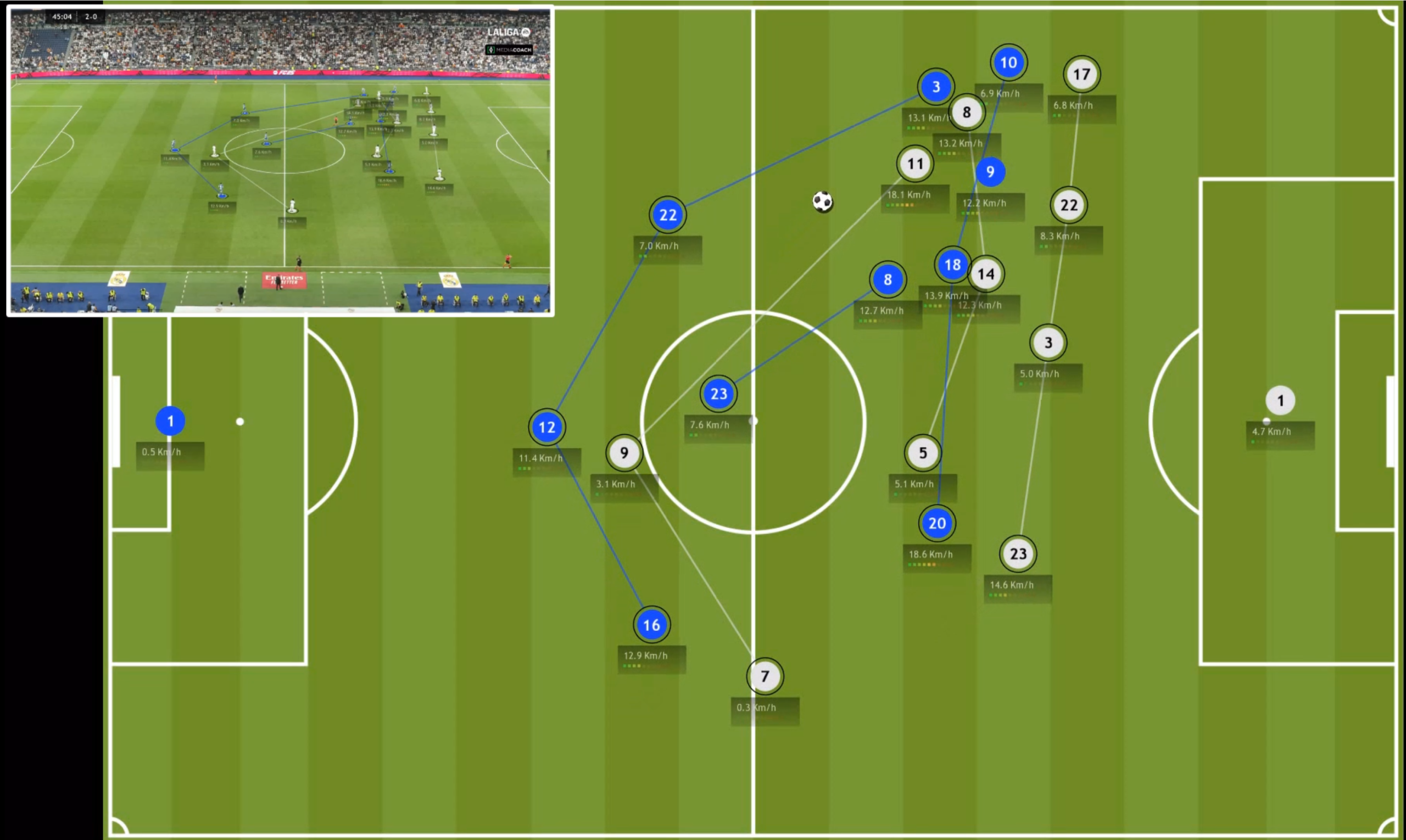
28 Oct Optimizing Speed in Football: Practical Applications for Coaches Based on Competitive Performance
Introduction:
Speed is one of the most critical physical abilities affecting football player performance. Based on data from players in the 2023/24 LALIGA EA Sports season, this research outlines a profile of average maximum speeds for each position, allowing coaches to tailor training to players’ specific needs. Below are the key findings, focusing on average maximum speeds in the offensive phase (when the team has possession) and the defensive phase (when the team does not), as well as acceleration and speed maintenance capacities over 10m, 20m, and 40m distances.
Key Metrics:
- % Efficiency in Possession Phases: This percentage shows how much of the average maximum speed in the defensive phase the player maintains in the offensive phase. It is calculated as the average maximum speed in the offensive phase divided by the average maximum speed in the defensive phase, expressed as a percentage. Higher efficiency indicates stability in both phases, which is essential for maintaining game rhythm.
- Acceleration Index (10m to 20m): Represents the player’s ability to increase speed over the first 20 meters. It is calculated by dividing the average maximum speed over 10 meters by the average over 20 meters, expressed as a percentage. A higher index indicates good initial acceleration, useful in short spaces.
- Speed Maintenance Index (20m to 40m): Reflects the player’s ability to sustain speed over longer distances. It is calculated as the average maximum speed at 20 meters divided by the average at 40 meters, also expressed as a percentage. A high index suggests the player can maintain speed over prolonged distances, essential for quick transitions.
Position-Specific Results:
- Wide Defenders – Speed in Quick Transitions
Wide defenders are among the fastest players on the field, averaging 31.05 km/h in the defensive phase, +2.8% above the global average. They also maintain a high percentage of speed in the offensive phase (90.65% efficiency, +1.4% above average), which enables them to advance quickly when the team has possession and transition to attack.- Acceleration Index: 89.71%, -0.3% below average, indicating effective initial acceleration to reach high speeds over short distances.
- Speed Maintenance Index: 96.56%, -0.2% below average, showing consistency in sustaining pace even during longer runs.
- Application: Simulate short and long sprints in training to better prepare these players to cover space in both defensive and offensive scenarios.
- Central Defenders – Control over Short Distances
With an average maximum speed of 30.26 km/h in the defensive phase (close to the average), central defenders do not require high peak speeds. Their efficiency in the offensive phase is 89.31%, slightly below the average, reflecting a minor drop in speed when their team is in possession. However, they excel in speed maintenance (97.38%), +0.8% above the average, indicating notable stability in sustaining their maximum speed during longer sprints.- Acceleration Index: 89.94%, +0.3% above average, showing controlled acceleration, ideal for their role in shorter distances.
- Speed Maintenance Index: 97.38%, +0.8% above average, essential for consistent movement during longer runs.
- Application: Acceleration drills in small spaces and stability with ball control can improve their performance in the defensive area.
- Forwards – Power in Offensive Sprints
Forwards reach an average maximum speed of 30.36 km/h in the defensive phase and have an acceleration index of 89.84%, on par with the average, ideal for explosive sprints in attack. Their efficiency in the offensive phase is 88.56%, slightly below average, showing a small reduction in speed during possession.- Speed Maintenance Index: 96.71%, matching the average, useful for sustaining speed in long runs toward the goal area.
- Application: Focus on long sprints and ball control exercises at high speeds to help them capitalize on their speed in attacking situations.
- Wide Midfielders – Endurance in Long Transitions
With an average maximum speed of 30.66 km/h in the defensive phase (+1.5% above the global average), wide midfielders excel in long transitions, both defensively and offensively. They have an efficiency index of 89.78% in the offensive phase and an acceleration index of 89.90%, matching the average, showing great capacity for responding in initial accelerations.- Speed Maintenance Index: 96.44%, -0.3% below average, sufficient to sustain speed in long-distance transitions.
- Application: Training focused on speed and endurance over long runs will help these players maintain their effectiveness in game transitions.
- Central Midfielders – Agility in Tight Spaces
At 28.86 km/h in the defensive phase (-4.4% compared to the global average), this position prioritizes mobility and control over peak speed. They stand out in acceleration from 10m to 20m (91.57%, +1.8% above average), essential for quick reactions in the midfield.- Speed Maintenance Index: 97.15%, +0.5% above average, showing they can maintain their maximum speed when required.
- Application: Agility and control drills in tight spaces will help these players improve their effectiveness in possession and distribution under pressure.
Summary of Position Data:
| Position | Defensive Phase Avg Max Speed (km/h) | Offensive Phase Avg Max Speed (km/h) | Efficiency (%) | Acceleration (10m-20m) | Speed Maintenance (20m-40m) |
|---|---|---|---|---|---|
| Wide Defender | 31.05 (+2.8%) | 28.15 (+4.3%) | 90.65 (+1.4%) | 89.71% (-0.3%) | 96.56% (-0.2%) |
| Central Defender | 30.26 (+0.2%) | 27.02 (+0.1%) | 89.31 (-0.1%) | 89.94% (+0.3%) | 97.38% (+0.8%) |
| Forward | 30.36 (+0.5%) | 26.88 (-0.4%) | 88.56 (-0.8%) | 89.84% (equal) | 96.71% (equal) |
| Wide Midfielder | 30.66 (+1.5%) | 27.53 (+2.0%) | 89.78 (+0.4%) | 89.90% (equal) | 96.44% (-0.3%) |
| Central Midfielder | 28.86 (-4.4%) | 25.58 (-5.2%) | 88.62 (-0.8%) | 91.57% (+1.8%) | 97.15% (+0.5%) |
Conclusion:
This analysis enables coaches to tailor the speed and acceleration training for each position according to their specific needs, improving their performance and responsiveness in real-game scenarios. Additionally, these insights help determine which player is best suited for each position or situation in a match based on the speed and endurance demands of their role.


